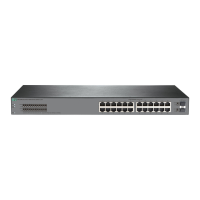3
• Long static ARP entry—It is directly used for forwarding packets. A long static ARP entry
contains the IP address, MAC address, VLAN, and output interface.
• Short static ARP entry—It contains only the IP address and MAC address.
If the output interface is a VLAN interface, the device sends an ARP request whose target IP
address is the IP address in the short entry. If the sender IP and MAC addresses in the received
ARP reply match the short static ARP entry, the device performs the following operations:
{ Adds the interface that received the ARP reply to the short static ARP entry.
{ Uses the resolved short static ARP entry to forward IP packets.
• Multiport ARP entry—It contains the IP address, MAC address, and VLAN.
The device can use a multiport ARP entry that has the same MAC address and VLAN as a
multicast or multiport unicast MAC address entry for packet forwarding. A multiport ARP entry is
manually configured. It does not age out and cannot be overwritten by any dynamic ARP entry.
For more information about multicast MAC, see the IGMP snooping configuration in IP Multicast
Configuration Guide.
To communicate with a host by using a fixed IP-to-MAC mapping, configure a short static ARP entry
on the device. To communicate with a host by using a fixed IP-to-MAC mapping through an interface
in a VLAN, configure a long static ARP entry on the device.
OpenFlow ARP entry
ARP creates OpenFlow ARP entries by learning from the OpenFlow module. An OpenFlow ARP
entry does not age out, and it cannot be updated. An OpenFlow ARP entry can be used directly to
forward packets. For more information about OpenFlow, see OpenFlow Configuration Guide.
Rule ARP entry
Rule ARP entries can be directly used for packet forwarding. A Rule ARP entry does not age out, and
it cannot be updated. It can be overwritten by a static ARP entry.
ARP creates Rule ARP entries by learning from the portal authentication module. For more
information about portal authentication, see portal authentication configuration in Security
Configuration Guide.
ARP tasks at a glance
All ARP tasks are optional.
• Configuring a static ARP entry
{ Configuring a short static ARP entry
{ Configuring a long static ARP entry
{ Configuring a multiport ARP entry
• Configuring features for dynamic ARP entries
{ Setting the dynamic ARP learning limit for a device
{ Setting the dynamic ARP learning limit for an interface
{ Setting the aging timer for dynamic ARP entries
{ Enabling dynamic ARP entry check
• Enabling ARP logging
Configuring a static ARP entry
Static ARP entries are effective when the device functions correctly.

